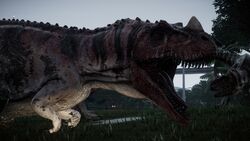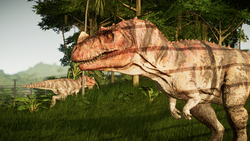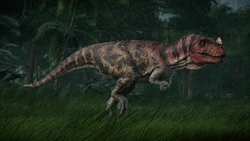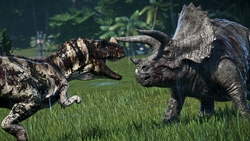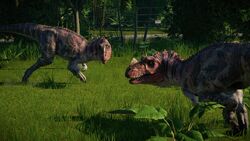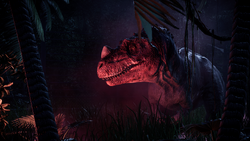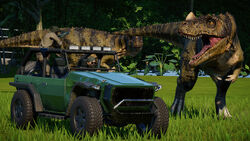Template:Era
Template:Dinosaur Infobox
| A carnivore, I see. This time, a Ceratosaurus. There are distinctive spines that run down its back. And a bladed horn on its head. Just what you don't want to run into when you are out there alone. Or in a group. |
Ceratosaurus is a genus of theropod dinosaur that originated from Late Jurassic North America, Africa, and Europe. Distinguished by a bladed horn on its snout, the Ceratosaurus is the first large carnivore available to the Hammond Foundation on Isla Matanceros.
History
Ceratosaurus was one of the animals illegally cloned by InGen on Isla Sorna in 1999, soon after the company had been acquired by Masrani Global. After InGen abandoned the cloning facility on Sorna, the Ceratosaurus was released into the wilds of the island, where it was briefly encountered by the survivors of a plane crash on the island in 2001.
The existence of the Ceratosaurus, which was absent on InGen's list, was later reported to the authorities, as with the presence of Corythosaurus, Ankylosaurus and a Spinosaurus, though these reports were later covered up.[1] It is unknown if any Ceratosaurs were transported to Isla Nublar when Jurassic World opened in 2005. As of 2018, it has been revealed that the Ceratosaurus population was the victim of an unconfirmed form of cruelty, likely referring to the aforementioned 1999 illegal cloning event.[2] It is unknown if there are any surviving populations.[3]
Description
The base genome of Ceratosaurus has a red head, neck, and upper back, and a creamy body with dark black stripes. It has a large number of osteoderms, a horn on its snout, and a smaller horn above each eye.
Behavior
Ceratosaurus is an aggressive and voracious predator, that targets mainly smaller herbivores but can also tackle larger herbivores, including Triceratops. They can either be housed alone, in pairs or in a group of three. They can also be housed safely with almost all sauropods, except Nigersaurus.
Paleontology
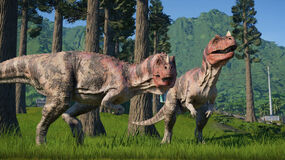
A pair of Ceratosaurus.
Ceratosaurus remains have been found in North America and Tanzania, and possibly in Portugal. In the Morrison Formation, it is one of the rarer theropods, being overshadowed by the more common Allosaurus. An interesting feature of Ceratosaurus are the lines of osteoderms, raised bony growths, down its back which are similar to a crocodile. These act as a type of armor, which suggests that Ceratosaurus competed with and even fought with larger carnivores such as Torvosaurus and Allosaurus. It can be deduced that Ceratosaurus was in the middle of the food chain or lived in a different area to these other predators. Its primary prey was small to medium ornithopod dinosaurs such as Dryosaurus, Camptosaurus or Othnielosaurus. There are some species of Ceratosaurus that have been estimated to be as big as some Allosaurus. However, there aren't enough bones to show how big the species actually got.
Ceratosaurus most famous feature is its three horns, one on its snout and two above its eyes. Originally it was believed to have been a dangerous weapon used to attack herbivores or rivals. In recent studies, it has been concluded that the horns were too blunt and fragile to be used as weapons and were more likely a display feature that helped it attract mates. Its four-fingered arms were short but strangely muscular and its fangs were some of longest in comparison to its skull with them going past its bottom jaw on some specimens which probably means its jaw could open incredibly wide to swallow food. It could possibly have used these fangs to rip out the jugular of larger prey. Ceratosaurus tail was very flexible and helped it swim which may point to it supplementing its diet with aquatic prey.
Even though the Ceratosaurus was smaller than the Allosaurus, it actually outlived the latter into the Cretaceous, as shown by its South American descendant Genyodectes.
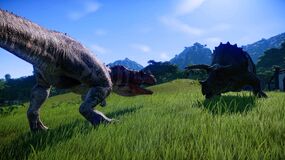
A Ceratosaurus fighting a Triceratops.
Paleoecology
All North American Ceratosaurus finds come from the Morrison Formation which had a semiarid environment with distinct wet and dry seasons. It housed a variety of different sauropods like Apatosaurus, Brontosaurus, Brachiosaurus, Camarasaurus, and Diplodocus. Other dinosaurs known from the Morrison Formation include theropods Allosaurus and Torvosaurus, as well as herbivores such as Dryosaurus and Stegosaurus.
A partial Ceratosaurus specimen indicates the presence of the genus in the Lourinhã Formation. Besides Ceratosaurus, Allosaurus and Torvosaurus were known to have lived in the area. Herbivorous dinosaurs from the formation include the sauropods Dinheirosaurus and Zby, as well as the stegosaur Miragaia.
Available genomes
| Fossil icon | Dig site | Quality | Number available |
|---|---|---|---|
| Lourinhã Formation | 1 3 3 | ||
| Morrison Formation | 1 6 3 3 |
Skins
![]() Jungle: Isla Matanceros Challenge Mode Jurassic Difficulty Unlock
Jungle: Isla Matanceros Challenge Mode Jurassic Difficulty Unlock
Trivia
- Ceratosaurus was the second dinosaur to receive a Species Profile, on 26 January 2018.
- Ceratosaurus is the first carnivore available in the game.
- Ceratosaurus is the second most sociable medium-large carnivore in the game, with the first being Spinoraptor.
- The base genome of the Ceratosaurus is based on its appearance in Jurassic Park III. However, in-game, Ceratosaurus is slightly different, with hornlets above the eyes, a more slender skull, blade-like teeth and four fingers similar to its real-life counterpart.
- Ceratosaurus appeared in Jurassic Park: Operation Genesis, considered by many to be Jurassic World Evolution's spiritual predecessor.
- In an update on 13 September, 2018, Ceratosaurus was slightly downsized. Despite this, the real life Ceratosaurus was still considerably smaller, averaging 6 to 7 meters in length and weighing between 275 and 980 kg.
Gallery
References
- ↑ Dinosaur Protection Group, What Killed the Gene Guard Act (http://www.dinosaurprotectiongroup.com/what-killed-the-gene-guard-act.html Dinosaur Protection Group Article)
- ↑ http://www.dinosaurprotectiongroup.com/images/posters/cruelty.jpg
- ↑ https://twitter.com/Jack_Ewins/status/1052300874163376129
External links
- Ceratosaurus on Wikipedia
- Jurassic Park III on Wikipedia
- Jurassic Park: Operation Genesis on Wikipedia
Template:JWEDinosaurs









